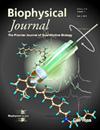Theoretical insights into rotary mechanism of MotAB in the bacterial flagellar motor
IF 3.2
3区 生物学
Q2 BIOPHYSICS
引用次数: 0
Abstract
Many bacteria enable locomotion by rotating their flagellum. It has been suggested that this rotation is realized by the rotary motion of the stator unit, MotAB, which is driven by proton transfer across the membrane. Recent cryo-electron microscopy studies have revealed a 5:2 MotAB configuration, in which a MotB dimer is encircled by a ring-shaped MotA pentamer. Although the structure implicates the rotary motion of the MotA wheel around the MotB axle, the molecular mechanisms of rotary motion and how they are coupled with proton transfer across the membrane remain elusive. In this study, we built a structure-based computational model for细菌鞭毛运动中 MotAB 旋转机制的理论启示
许多细菌通过旋转鞭毛来实现运动。有人认为,这种旋转是通过定子单元 MotAB 的旋转运动实现的,而 MotAB 是由质子跨膜转移驱动的。最近的冷冻电镜研究揭示了一种 5:2 的 MotAB 构型,其中 MotB 二聚体被环形的 MotA 五聚体包围。尽管该结构暗示了 MotA 轮围绕 MotB 轴的旋转运动,但旋转运动的分子机制以及它们如何与质子跨膜转移耦合在一起,仍然令人难以捉摸。在这项研究中,我们为空肠弯曲杆菌的 MotAB 建立了一个基于结构的计算模型,进行了全面的质子化状态依赖性分子动力学模拟,并揭示了一个合理的质子转移耦合旋转途径。该模型假设质子转移依赖于旋转,质子从MotB的外质侧吸收到保守的天冬氨酸,然后质子跳转到MotA的质子携带位点,接着质子输出到CP。我们认为,通过将 MotA 的两个质子携带位点保持在去质子化状态,MotA 五聚体在每次质子跨膜转移时都能稳健地旋转 36°。我们的研究结果为细菌鞭毛马达中 MotAB 的旋转运动提供了一个基于结构的机理模型,并为各种离子驱动的旋转分子马达提供了启示。
本文章由计算机程序翻译,如有差异,请以英文原文为准。
求助全文
约1分钟内获得全文
求助全文
来源期刊

Biophysical journal
生物-生物物理
CiteScore
6.10
自引率
5.90%
发文量
3090
审稿时长
2 months
期刊介绍:
BJ publishes original articles, letters, and perspectives on important problems in modern biophysics. The papers should be written so as to be of interest to a broad community of biophysicists. BJ welcomes experimental studies that employ quantitative physical approaches for the study of biological systems, including or spanning scales from molecule to whole organism. Experimental studies of a purely descriptive or phenomenological nature, with no theoretical or mechanistic underpinning, are not appropriate for publication in BJ. Theoretical studies should offer new insights into the understanding ofexperimental results or suggest new experimentally testable hypotheses. Articles reporting significant methodological or technological advances, which have potential to open new areas of biophysical investigation, are also suitable for publication in BJ. Papers describing improvements in accuracy or speed of existing methods or extra detail within methods described previously are not suitable for BJ.
 求助内容:
求助内容: 应助结果提醒方式:
应助结果提醒方式:


